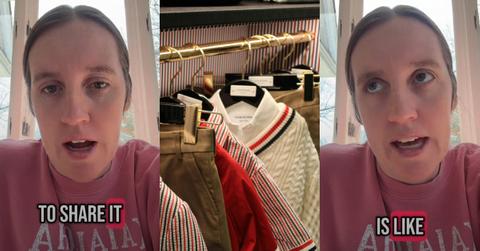Mom Surprised to Learn the Difference Between “24M” and “2T” Clothing
"Now it makes so much sense."
Published April 24 2025, 9:40 a.m. ET
There are tons of things new parents have to learn, and one mom was surprised to discover that there are distinct sizing mechanisms when it comes to children's clothing.
While some folks may roll their eyes at parents who refer to their children as being 28 months old instead of saying "They're 2," there's a specific reason why some kids' clothing is measured in this fashion.
Winnie (@wondersof__winnie) shared how she learned of the difference between "M" and "T" clothing while shopping for her 2-year-old daughter. She thought that 24-month and 2T sizes were exactly the same, and told a Target worker she was looking for either of these sizes.
"I learned something yesterday at Target that they don't tell moms. And I was shocked to learn this, so I wanted to share it. I was in the baby/toddler section yesterday shopping for my daughter. There was an associate there and I couldn't find something. So they were helping me."
During their discussion, the TikToker let the associate know that they were specifically looking for 24 months or 2T clothing for their child, thinking that these sizes meant the same thing. However, she soon learned that this wasn't the case.
"We started talking about sizing, and I was just like 24 months or 2T, she's 2."
Winnie goes on to state that although she had never previously considered there was a difference between these two sizes, once the Target employee explained what the contrast was between these sizes, it clicked in her mind.
"And they explain to me the difference, which I never really thought about before. But now it makes sense."
As it turns out, the distinction all boils down to whether or not your baby is still wearing a diaper. If they are, then you should opt for clothing that has its sizing measured out in months.
"So when things are in months, like up to 24 months, it is like around the assumption that your baby is wearing a diaper."

The TikToker went on to explain: "So the cut is slightly different. When it gets to T like a 2T or a 3T, the assumption is they're no longer wearing a diaper, so they're in underwear. And so the cut is different from that perspective."
She shared that she was shocked to learn about this difference in baby sizing nomenclature. "Obviously, they don't have, like, a handbook for parents, but I never knew this. And it, it makes so much sense now."
At the end of her video, she asked her viewers if they were privy to this information beforehand. "Is this something you knew?"
As it turns out, folks had varying opinions. One person in the comments section replied that they were told there is indeed a size difference, however, it wasn't explained in those exact same terms.

"Interesting. I was once told 2T was simply longer than 24 mo, but waist size was the same," one person penned.
Another person said that these sizing distinctions don't account for the developmental stages of all babies.
Another replied that they found it unrealistic for 2-year-old kids to already be potty trained. "How many 2-year-olds are out of diapers?" they asked.
To which Winnie replied, "Hahah it seems like maybe around 2.5 years some are? I don’t even know; we haven’t gotten there yet but I’m excited for my bank account."

Whereas someone else commented on their own kids' sizing woes. "I did know, but I wish they made diaper-friendly items in 3/4T bc my kid was in 3T at 15 months old."
According to Healthy Children, the majority of American kids are potty trained between the ages of 2 and 3 years old.
Furthermore, the website states that a good time to bring up the topic of potty training is the 18-month, 2-year, 2-and-a-half-year, and 3-year child visits. The same article says that parents are free to potty train their kids whenever they feel it is a good time to do so, however, and that children can very well start earlier.

If you're wondering when a good time to try and get your kids ready to be potty trained, the website states that there are some indicators for parents to follow. For instance, if they're "dry at least two hours at a time during the day" or are "dry during naps" then you might want to start training them to ditch the diaper.
This way, like Winnie stated, you can start saving money on diapers and give them the independence to go potty all by themselves. Plus, you can head on over to the "T" section of clothing without having to worry about the extra fabric that compensates for the additional diaper coverage.
